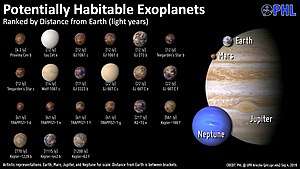Habitable exoplanet
A potentially habitable exoplanet is a hypothetical type of planet that could be habitable for humans.[1] As of March 2020, a total of 55 potentially habitable exoplanets have been found.[2] Of those, one is believed to be Sub-terran (Mars-size), 20 Terran (Earth-size) and 34 Super Terran (Super Earths).[3] The most potentially habitable exoplanet discovered so far is Teegarden b, with an Earth Similarity Index of 0.93.[4] The main feature of potentially habitable exoplanets is that they have to be located in the habitable zone of their stellar systems.

Characteristics
Mass
In order to be potentially habitable, an exoplanet would have to have a mass between 0.1 and 10 Earth masses.[5]
Radius
The radius of a habitable exoplanet would range between 0.5 and 2.5 Earth radii.[6]
Temperature
The temperature among the habitable exoplanets discovered so far range from 182 degrees Kelvin (Kepler 186 f) and 285 degrees Kelvin (Tau Ceti e).[7]
Host star
It is believed that F, G, K and M-type star could host habitable exoplanets.[8] G-type stars would allow to host the exoplanets most similar to Earth, that is, Earth-like planets.[9] K-type stars would provide the necessary conditions for super habitable exoplanets, which are exoplanets that could be more habitable than Earth.[10] As of March 2020, only one potentially habitable exoplanet has been found orbiting a F-type star: Kepler-1632 b.[11]
M-type stars also considered possible hosts of habitable exoplanets, even those with flares such as Proxima b. However, it is important to bear in mind that flare stars could greatly reduce the habitability of exoplanets by eroding their atmosphere.[12]
References
- "Habitable Exoplanet Observatory (HabEx)". www.jpl.nasa.gov. Retrieved 2020-03-31.
- "The Habitable Exoplanets Catalog - Planetary Habitability Laboratory @ UPR Arecibo". phl.upr.edu. Retrieved 2020-03-31.
- "The Habitable Exoplanets Catalog - Planetary Habitability Laboratory @ UPR Arecibo". phl.upr.edu. Retrieved 2020-03-31.
- "The Extrasolar Planet Encyclopaedia — Teegarden's b". exoplanet.eu. Retrieved 2020-03-31.
- Raymond, S. N.; Quinn, T.; Lunine, J. I. (2005). "High-resolution simulations of the final assembly of Earth-like planets 2: water delivery and planetary habitability". Astrobiology. 7 (1): 66–84. doi:10.1089/ast.2006.06-0126. PMID 17407404.
- "On the radius of habitable planets" (PDF).
- "The Habitable Exoplanets Catalog - Planetary Habitability Laboratory @ UPR Arecibo". phl.upr.edu. Retrieved 2020-03-31.
- "Habitable Exoplanet Observatory (HabEx)". www.jpl.nasa.gov. Retrieved 2020-03-31.
- Petigura, Erik A.; Howard, Andrew W.; Marcy, Geoffrey W. (2013-11-26). "Prevalence of Earth-size planets orbiting Sun-like stars". Proceedings of the National Academy of Sciences. 110 (48): 19273–19278. arXiv:1311.6806. Bibcode:2013PNAS..11019273P. doi:10.1073/pnas.1319909110. ISSN 0027-8424. PMC 3845182. PMID 24191033.
- Heller, René; Armstrong, John (2014). "Superhabitable Worlds". Astrobiology. 14 (1): 50–66. arXiv:1401.2392. Bibcode:2014AsBio..14...50H. doi:10.1089/ast.2013.1088. ISSN 1531-1074. PMID 24380533.
- "Exoplanet-catalog". Exoplanet Exploration: Planets Beyond our Solar System. Retrieved 2020-03-31.
- "Habitable Exoplanet Observatory (HabEx)". www.jpl.nasa.gov. Retrieved 2020-03-31.